- How to Propagate Monstera Guide: The Three Ways to Succeed - September 17, 2021
- Escargot Begonia: Why Is The Rex Begonia So Rare? - August 31, 2021
- Rieger Begonia: When You Can Expect The Hiemalis Begonia To Flourish - August 31, 2021
This Pothos plant is ideal for growing indoors . It does not require a lot of tedious care or expensive equipment to grow either. All these features combined make Jessenia Pothos the perfect plant for gardeners of all skill levels.
How to Identify Jessenia Pothos
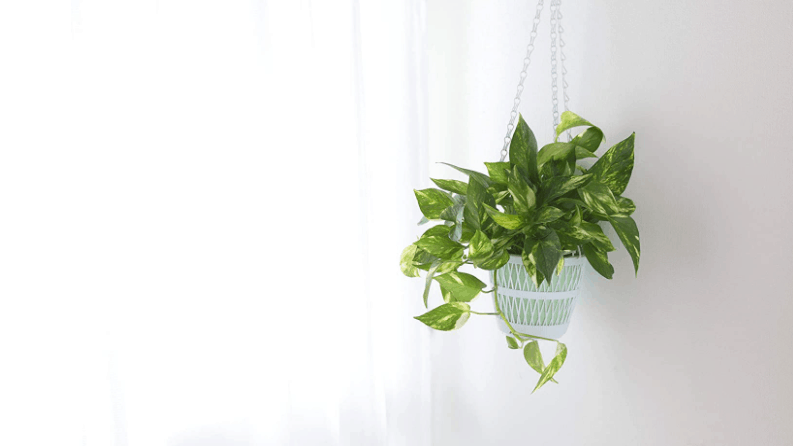
Pothos varieties all look very similar so it can be difficult to tell one from another. It is always best to check the labels before purchasing any type of plant. If you are looking for Jessenia Pothos, though, you will need to look for these key identifiers:
- heart-shaped leaves
- Leaves that are lime green but variegated with a darker green color
- Leaves that have a smooth texture
- Leaves that are mildly glossy
How to Grow Jessenia Pothos from Seed
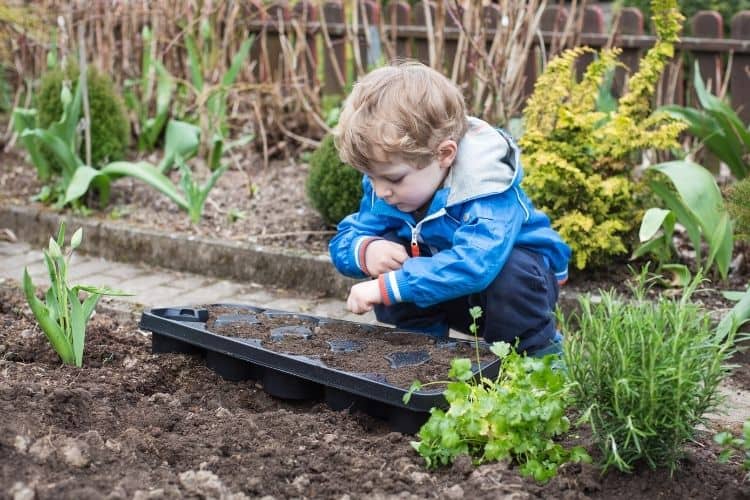
It is no secret that Pothos plants are difficult to grow from seeds. The reason for this is because they don’t produce seeds very often. Also, they take a long time to grow from seeds and most gardeners find that they are easier to grow from stem cuttings. But, it is possible to do so, and if you choose to go this route to grow Jessenia Pothos, follow these steps:
- Purchase seeds from a reputable seller (sellers who price their seeds between $1 and $2)
- Soak the seeds in water for 24 to 48 hours
- Fill either a seed starter tray or a small plant container with a seed starting soil mix
- Plant the seeds in the soil mix
- Water the soil so that it is moist but not soggy
- Place either plastic wrap or the lid of the tray over the top of the container
- Set the container in a warm spot that gets plenty of bright, indirect sunlight
- Once sprouts appear above the soil level, acclimatize them to open air
- Once the plants are established, move them to a more permanent plant container
How to Propagate Jessenia Pothos
Gardeners know that the easiest way to grow a new Pothos plant, regardless of the variety, is via stem cuttings.
It is easy to do because it can be during pruning sessions or anytime a new plant is desired and because the cuttings take root so easily. The steps for doing this are as follows:
- Using a sterile cutting utensil, cut off a healthy stem that includes a leaf and a node
- Set the stem in a container filled with water
- Set the container in a place that gets bright but indirect sunlight
- Change the water every other week
- Once roots are an inch long, plant the stem in a container filled with potting soil that contains a mixture of perlite
- Water the potting soil and keep it moist but not soggy
Jessenia Pothos Growing Conditions
The best way to provide an environment that is ideal for growing Jessenia Pothos is to gather a few key pieces of equipment.
- A Pebble tray to provide extra humidity or a Plant humidifier to provide extra humidity
- A Plant Heat Mat to provide extra warmth
The reason why all this extra equipment may be necessary is that these are tropical plants that naturally grow on islands in the South Pacific.
They thrive in temperatures that range between 65 and 80 degrees Fahrenheit with humidity levels that range between 50% and 70%.
If you don’t mind providing this climate indoors, then there is no need to purchase the extra equipment, but if this combination of high humidity and high temperatures sounds stuffy, you might want to splurge for them.
How to Plant Jessenia Pothos
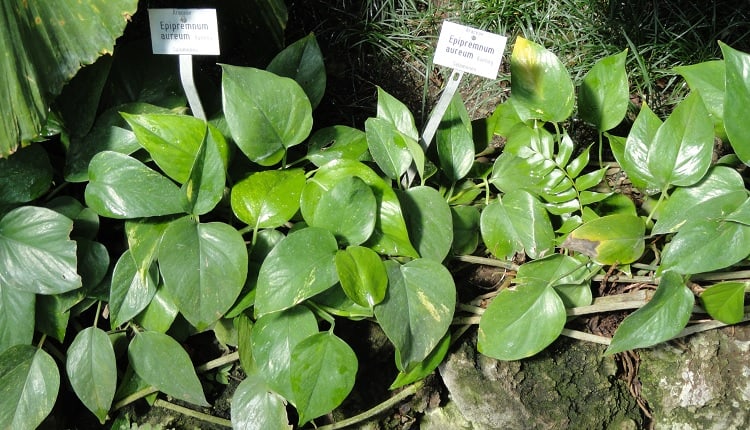
You should expect to replant your Jessenia Pothos every two to three years. This will provide the plant with new, fresh soil and a chance to grow bigger and stronger roots. It is also a chance for you to propagate new Pothos plants. Signs that a plant needs repotted are:
- Compacted Soil
- Roots that are crowded and growing into a ball formation
- A plant that looks too big for its current container
The steps for repotting a Pothos plant are:
- Fill a new container that is two inches larger than its previous container with potting soil
- Create a hole in the soil for the plant to set inside
- Carefully remove the plant from its current container by laying the plant on its side and then pulling the pot off the root system
- Gently dust off any excess soil from its roots
- Set the plant into the hole in the new container
- Spread the soil around so that the plant is secure in its new container
- water the plant
- Set it in a warm spot with indirect sunlight
Jessenia Pothos Potting & Soil
The type of soil and the planting container used to house a plant are two of the most important factors for growing happy and healthy plants. Pothos plants, no matter the variety, require soil that is able to drain well but still hold some moisture.
The soil also needs to include plenty of organic material that will provide nutrients to the plant. This is why Happy Frog potting soil is an excellent choice for all Pothos varieties.
When it comes to selecting a plant container for your Pothos plant, look for something that is sturdy, has drainage holes, and if possible, is made from plastic. Plastic containers will retain some moisture and heat, which is what Pothos plants need.
Don’t forget that Pothos plants require their soil to have a particular pH level range. For Jessenia Pothos, keep the pH levels between 6.1 and 6.5.
If you need to test the soil, use the Soil pH Meter . If you need to adjust the levels, read this article for a more thorough explanation of how this is done, but know it is a straightforward process of adding select ingredients to your soil.
For more alkaline soil add the following ingredients to your soil:
- Aged sawdust
- Wood chips
- Peat moss
- Pine needles
- Oak leaves
For more acidic soil add the following ingredients to your soil:
- Bone meal
- Hardwood Ashes
- Ground eggshells
Jessenia Pothos Water Requirements
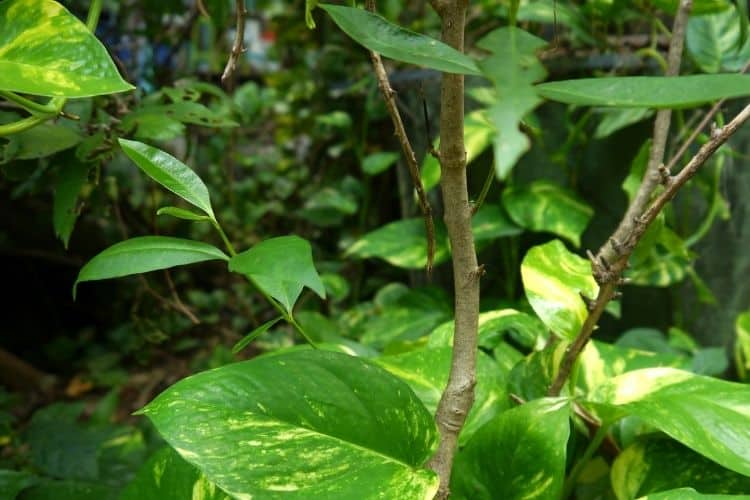
This may be a tropical plant but it can still get into some serious trouble if it is overwatered. Pothos plants are actually able to harden drought conditions for a short period of time, so it is always best to check the plant’s soil before giving it any water.
If the top two inches of the plant’s soil is dry, it can use a drink; however, if the top two inches are still moist, it does not need any more water. Pothos plants should be deeply watered until the excess water flows out of their container’s drainage holes. If any excess water accumulates in the container’s saucer, it should be discarded.
Take advantage of modern technology by using a plant watering app. This type of app can help track when a plant has been watered, set reminders to water it, and get answers to common plant care questions.
Jessenia Pothos Light Requirements
Just like most Pothos varieties, Jessenia Pothos plants grow and look their best when placed in a spot that gets plenty of bright, indirect sunlight. Too much direct sunlight will dry out and burn their leaves, but too light sunlight will cause the plant to grow sluggish and lose its color variegation.
Once again, modern technology can assist you when selecting a place to set your plant. Light meters are able to test indoor light capacity so you can be sure that your plant is receiving the amount of sunlight it needs.
Best Jessenia Pothos Fertilizer
Most Pothos are not heavy feeders and Jessenia Pothos is one such plant. It should only be fed in the following cases:
- For an extra boost during the spring growing season
- When the plant looks weak
- When the plant’s growth is stunted
Worm compound or a 5-5-5 fertilizer are the best types to use on a Jessenia Pothos plant.
Best Glacier Pothos Companion Plantings
A gardener’s secret for giving tropical plants more humidity without creating a stuffy and sticky house is to cluster tropical plants together. These plants share similar care needs and the extra humidity they give off. Plus, they look absolutely wonderful together.
There are many tropical plants that can be used as companion plants for Jessenia Pothos, but consider using one of the following:
Monster Varieties
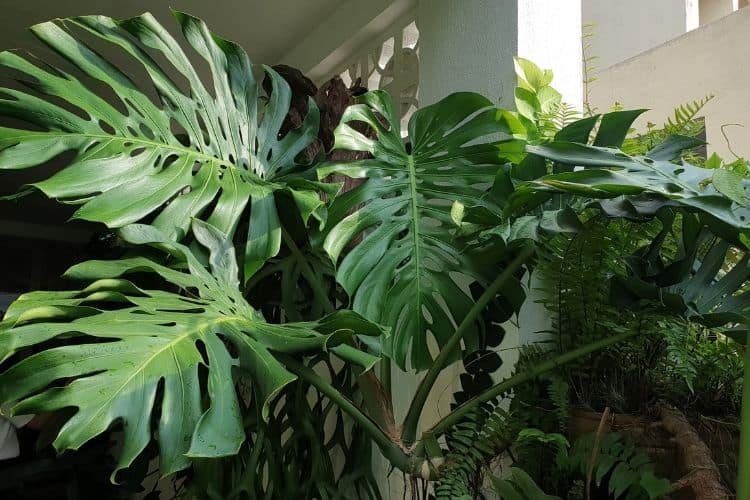
These tropical plants will provide your Pothos plant with extra humidity without any hassle. Not only do their care requirements resemble those of Pothos plants, but they are also very beautiful. It is a gardener’s dream to have two unfussy and beautiful plants in the same garden.
Pros
- Monstera plants are highly decorative houseplants
- Monstera plants are easy to care for with care requirements that are similar to Pothos plants
- Certain Monstera varieties produce edible fruits
Cons
- Monstera plants are slightly toxic
Peperomia Obtusifolia
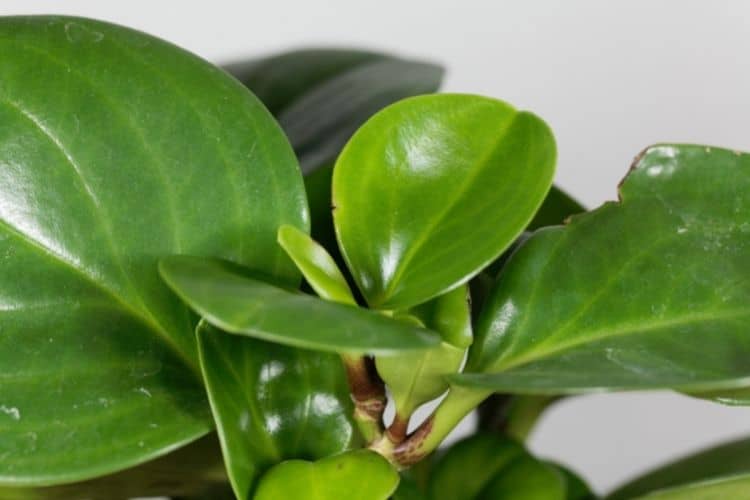
This is also known as the baby rubber plant and it is absolutely adorable. These are the types of plants that look like plastic and can be featured on living walls. It may be from an entirely different family than Jessenia Pothos, but so many of its care requirements are the same.
Pros
- Baby Rubber Plant is not toxic
- Baby Rubber Plant requires the same growing environment as Jessenia Pothos
- Baby Rubber Plant only grows up to a foot tall
Cons
- None
Pink Princess Philodendron
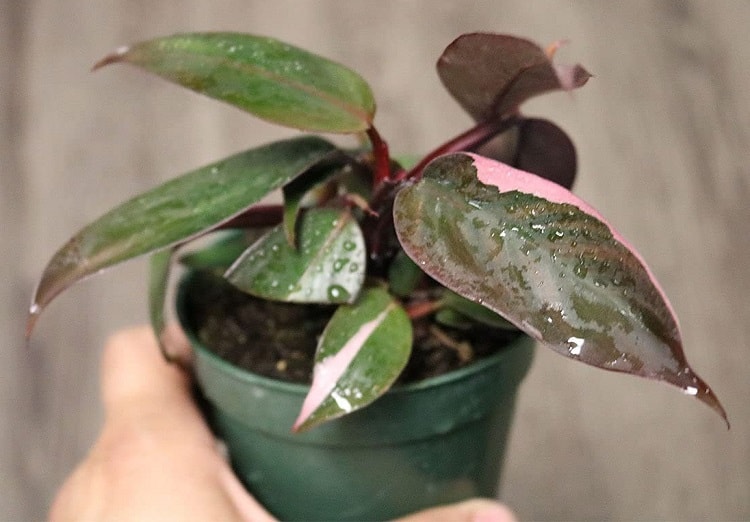
This is one of the most gorgeous and sought-after plants on the market. It may be a rarity and difficult to acquire, but its beauty is well worth the effort.
Pros
- Pink Princess is a unique-looking and beautiful plant
- Pink Princess requires the same amount of sunlight, the same type of soil, and the same watering method as Jessenia Pothos
Cons
- Pink Princess is difficult to find
- pink princess is expensive
- Pink Princess is susceptible to infestations of mealy bugs, spider mites, and scale insects
- Pink Princess is susceptible to mosaic virus
- Pink Princess is toxic
Jessenia Pothos Diseases and Common Problems
Pothos plants face many of the same types of problems and Jessenia Pothos is no different. These diseases and pests should not be a huge problem if you learn how to properly care for your plant. Here are the most common issues faced by Pothos plants:
Bacterial Wilt
Evidence of this disease are leaves that wilt and stem veins that turn black. This is an extremely contagious and fast-growing infestation for plants. Any plant that shows evidence that it has bacterial wilt should be quarantined from other plants. To do with this type of infestation, follow these steps:
- Remove the plant from its container
- Wash off all the dirt from its roots
- Replant the plant in a clean container with fresh soil
- Use a plant protector such as Wilt Stop
Ethylene Damage
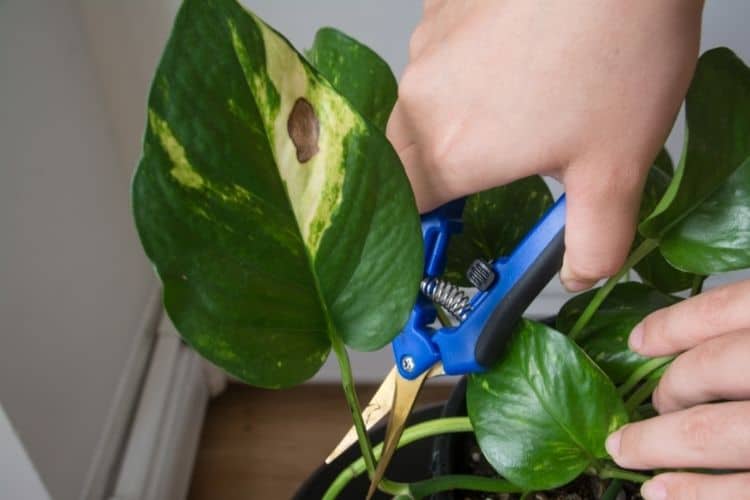
Evidence of this problem is leaves that are yellow, then turn tan, then become light brown while the moisture level of the plant’s soil is agreeable. Typically, this issue is faced by plants that are kept in a greenhouse with heaters. To treat this issue, it is necessary to check that the greenhouse has adequate ventilation.
Manganese Toxicity
Evidence of this problem is leaves that drop prematurely and have yellow marks or flecks on them and darkened veins. To deal with this issue, it is necessary to discontinue the use of any fertilizer that contains manganese and to add lime to the soil so that its pH levels range between 6 and 6.5.
Mealybugs
Evidence of an infestation of mealybugs is small white spots that look like cotton on leaves and stems. To deal with an infestation of mealybugs, follow these steps:
- Spray a solution of alcohol and water on the leaves
- Rub the leaves with a cotton ball
- Coat the leaves in neem oil or insecticidal soap every few days
Root Rot
Evidence of this problem is leaves that have turned brown or black. To treat this problem, let the soil dry out completely and set the plant in a place where it will get plenty of airflow.
If it is still struggling with too much water in its container, follow these steps:
- Remove the plant from its container
- Wash off all the dirt from its roots
- Cut off any roots that are rotten
- Replant the plant in a clean container with fresh soil
- Wait to water it for a few days
Southern Blight
Evidence of this problem is strands of white, feathery fungus growing on top of the soil and on the plant’s stems. To deal with this problem, it is necessary to discard the plant and plant container completely so that it cannot pass on the infestation to other plants.
This disease is usually caused by contaminated soil. Refrain from storing potting soil directly on the ground since this is the best way for Sclerotium rolfsii to grow into a colony.
Jessenia Pothos Treatments and Maintenance
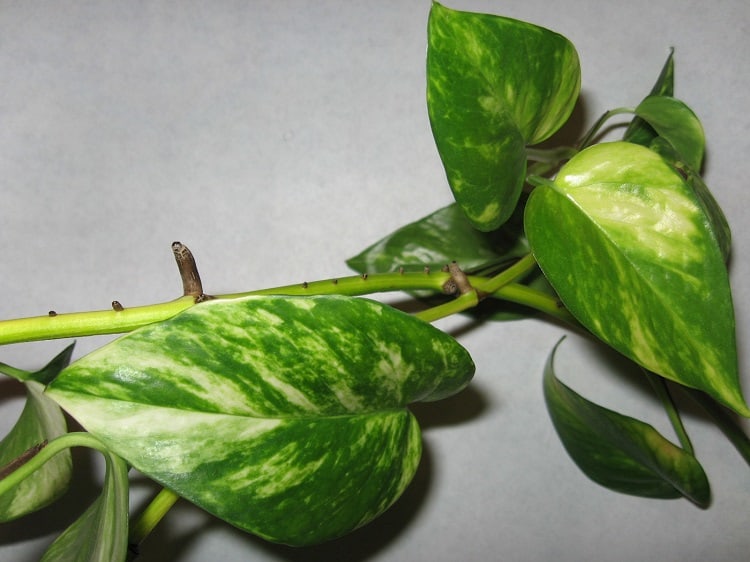
Pothos plants that are cared for regularly will have a better chance of avoiding common problems and recovering from them as well. The best way to prevent harmful diseases and pest infestations is to provide the plant with regular care and cleaning. Here are a few tips to help keep your plant as healthy as it can be.
- Check it for signs of disease and infestations regularly, and treat them quickly.
- Clean the plant’s leaves regularly with neem oil.
- Learn how to properly water and feed your plant.
- Make sure your plant is set in an area with adequate amounts of sunlight, heat, and humidity.
- Mix diatomaceous earth into the soil of potted plants.
Where to Buy Jessenia Pothos Seeds Online
Pothos seeds from every variety are difficult to find because these plants are easier to propagate via stem cuttings and Pothos plants do not produce seeds very often as houseplants. When you search for seed sellers, look for those who have good ratings and price their seeds between $1 and $2 per seed.
Where to Buy Mature Jessenia Pothos Online
While Glacier Pothos seeds may be difficult to come by, mature plants are not. Etsy is the best online shop to search for this plant.
FAQs
Question: Is Jessenia Pothos Toxic?
Answer: Unfortunately, yes. Jessenia Pothos is just like most Pothos varieties in that it is toxic to pets and children. If someone has consumed one of these plants, call a medical professional or poison control immediately.
• Poison Control Center
• Animal Poison Control
• Ask a Poison Control Vet
Question: Is Jessenia Pothos the Same Plant as Golden Pothos?
Answer: No, these are actually two different varieties of Pothos, but they do have a lot of the same key features.
Question: In Which USDA Hardiness Zone Can Jessenia Pothos Be Planted?
Jessenia Pothos should only be planted in the ground if you live in zones 10 and 11. If you live in zones lower than these, they should be planted in a container that can be transferred indoors during winter.
In Conclusion
Jessenia Pothos is another example of what nature offers to those of us who love gardening but need something uncomplicated. With this type of plant, there are no excuses for not growing a garden.

